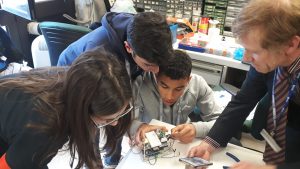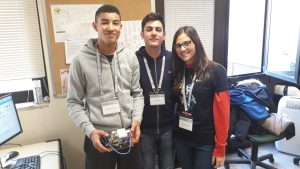The Air Quality Platform (AQP) was initially designed to support the School Experiment at the Living Planet Symposium (LPS) 2019 in Milan. From then on, the project evolved in different directions. This website hosts the online map of all AQPs currently deployed around Europe and contains information on the LPS School Experiment, for historical reasons.

Quick Start Guide
The Quick Start Guide is the most complete reference available for anyone wishing to assemble, configure and operate an AQP from scratch, even if in some aspects its contents were thought specifically for the LPS School Experiment context and may not be entirely applicable or updated.
What is the Air Quality Platform?
The Air Quality Platform is a small platform based on a Raspberry Pi computer and equipped with a set of sensors that measure different characteristics of the ambient air. On top of that, the platform comes with a GPS receiver for localization.
The platform measures: particulate matter (PM2.5 and PM10), carbon monoxide (CO), nitrogen dioxide (NO2), ammonia (NH3), carbon dioxide (CO2), temperature and humidity. It uses its Raspberry Pi to access the internet (via Wi-Fi) and send data to a centralized server. This website then allows visualizing the location of the several AQPs and their respective measurements in real time. The map widget also allows comparing the measurements with the latest data obtained by the Copernicus Sentinel-5p satellite.
LPS SCHOOL EXPERIMENT: AIR QUALITY STATION
The LPS School Experiment, organized in May 2019, offered high school students (14 to 18 years) the unique opportunity to be part of an European Space Agency (ESA) project and assemble and operate their own air quality (AQ) station.
What did students do?

Students building a AQ station in the ESA EO laboratory
The schools selected for participation received an AQ station from ESA and had to connect the different sensors to the Raspberry Pi to set up the station. They also had to ensure that the station had Wi-Fi access.
Once the station was set up and configured, students started to make some measurements. The station could be set up outside (but protected from rain and direct sunlight) or students could walk around with it to measure air quality parameters in different environments. Naturally, the station requires power to operate, which can be obtained using the power cable included as part of the kit or using a power bank (ideal for mobile measurements).

Students with the air quality station
The goal was to make use of the different sensors and capabilities of the air quality station to investigate interesting phenomena, learn about air quality and the composition of the ambient air. Students were stimulated to ask themselves and try to answer questions such as:
- How do measurements change along a busy street versus in a park?
- How does the air quality at the school change throughout the day?
- Are the sensor readings different on rainy days with respect to sunny days?
Moreover, students could design their own experiments.
What was the ESA 2019 Living Planet Symposium?
The Living Planet Symposium (LPS) is a large international conference, which is held every three years. In 2019, it took place on 13–17 May in Milan, Italy. It was organized by ESA with the support of the Italian Space Agency (ASI). The thematic focus was on how Earth Observation contributes to science and society, and how disruptive technologies and actors change the traditional Earth Observation landscape, creating new opportunities for public and private sector interactions.
For more information about the ESA 2019 Living Planet Symposium click here.
LPS 2019 School Lab
The Living Planet Symposium 2019 was also the frame for the third edition of the LPS School Lab. This week-long event included exciting presentations and hands-on experiments on Earth and Space Sciences given and led by international experts in the field and aimed at high school students. Other than ESA, the Italian Space Agency ASI, the German Centre for Aerospace – DLR –, the Italian National Institute of Geophysics and Volcanology (INGV), the UK Space Agency and the University of Pavia and Polytechnic University of Milan participated. This meant that students had the unique opportunity to meet scientists and get an insight into the fields of Space and Earth Sciences.
Disclaimer
The AQP and the LPS School Experiment bring together the topics of Citizen Science, Internet of Things and Space Science. Keep in mind, however, that the platform’s sensors are not calibrated according to scientific standards and should therefore only be used for educational purposes. Furthermore, the gas sensors are sensitive to a large variety of gases, which makes it difficult to estimate the exact contribution of each gas to the measured signal.
Copyright 2021 © European Space Agency. All rights reserved

